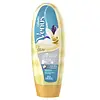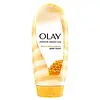What's inside
What's inside
 Key Ingredients
Key Ingredients

 Benefits
Benefits

 Concerns
Concerns

 Ingredients Side-by-side
Ingredients Side-by-side

Water
Skin ConditioningPetrolatum
EmollientSodium Trideceth Sulfate
CleansingSodium Lauryl Sulfate
CleansingParaffinum Liquidum
EmollientSodium Lauroamphoacetate
CleansingSodium Chloride
MaskingTrideceth-3
EmulsifyingParfum
MaskingCitric Acid
BufferingGuar Hydroxypropyltrimonium Chloride
Skin ConditioningAcrylonitrile/Methacrylonitrile/Methyl Methacrylate Copolymer
AbsorbentXanthan Gum
EmulsifyingSodium Hydroxide
BufferingSodium Benzoate
MaskingPEG-90m
Emulsion StabilisingDisodium EDTA
Isopentane
SolventMethylchloroisothiazolinone
PreservativeMethylisothiazolinone
PreservativeButyrospermum Parkii Butter
Skin ConditioningTriethoxycaprylylsilane
Iron Oxides
CI 15985
Cosmetic ColorantWater, Petrolatum, Sodium Trideceth Sulfate, Sodium Lauryl Sulfate, Paraffinum Liquidum, Sodium Lauroamphoacetate, Sodium Chloride, Trideceth-3, Parfum, Citric Acid, Guar Hydroxypropyltrimonium Chloride, Acrylonitrile/Methacrylonitrile/Methyl Methacrylate Copolymer, Xanthan Gum, Sodium Hydroxide, Sodium Benzoate, PEG-90m, Disodium EDTA, Isopentane, Methylchloroisothiazolinone, Methylisothiazolinone, Butyrospermum Parkii Butter, Triethoxycaprylylsilane, Iron Oxides, CI 15985
Water
Skin ConditioningPetrolatum
EmollientSodium Trideceth Sulfate
CleansingParaffinum Liquidum
EmollientSodium Chloride
MaskingGlycine Soja Oil
EmollientCocamidopropyl Betaine
CleansingParfum
MaskingTrideceth-3
EmulsifyingSodium Citrate
BufferingGuar Hydroxypropyltrimonium Chloride
Skin ConditioningSodium Benzoate
MaskingXanthan Gum
EmulsifyingCitric Acid
BufferingDisodium EDTA
BHT
AntioxidantGlyceryl Oleate
EmollientAcrylates/C10-30 Alkyl Acrylate Crosspolymer
Emulsion StabilisingButyrospermum Parkii Butter
Skin ConditioningMethylchloroisothiazolinone
PreservativeMethylisothiazolinone
PreservativeIron Oxides
Water, Petrolatum, Sodium Trideceth Sulfate, Paraffinum Liquidum, Sodium Chloride, Glycine Soja Oil, Cocamidopropyl Betaine, Parfum, Trideceth-3, Sodium Citrate, Guar Hydroxypropyltrimonium Chloride, Sodium Benzoate, Xanthan Gum, Citric Acid, Disodium EDTA, BHT, Glyceryl Oleate, Acrylates/C10-30 Alkyl Acrylate Crosspolymer, Butyrospermum Parkii Butter, Methylchloroisothiazolinone, Methylisothiazolinone, Iron Oxides
Alternatives
Ingredients Explained
These ingredients are found in both products.
Ingredients higher up in an ingredient list are typically present in a larger amount.
This ingredient is also known as shea butter. It is an effective skin hydrator and emollient.
Emollients help soothe and soften your skin. It does this by creating a protective film on your skin. This barrier helps trap moisture and keeps your skin hydrated. Emollients may be effective at treating dry or itchy skin.
Shea butter is rich in antioxidants. Antioxidants help fight free-radicals, or molecules that may harm the body. It is also full of fatty acids including stearic acid and linoleic acid. These acids help replenish the skin and keep skin moisturized.
While Shea Butter has an SPF rating of about 3-4, it is not a sunscreen replacement.
Shea butter may not be fungal acne safe. We recommend speaking with a professional if you have any concerns.
Learn more about Butyrospermum Parkii ButterCitric Acid is an alpha hydroxy acid (AHA) naturally found in citrus fruits like oranges, lemons, and limes.
Like other AHAs, citric acid can exfoliate skin by breaking down the bonds that hold dead skin cells together. This helps reveal smoother and brighter skin underneath.
However, this exfoliating effect only happens at high concentrations (20%) which can be hard to find in cosmetic products.
Due to this, citric acid is usually included in small amounts as a pH adjuster. This helps keep products slightly more acidic and compatible with skin's natural pH.
In skincare formulas, citric acid can:
While it can provide some skin benefits, research shows lactic acid and glycolic acid are generally more effective and less irritating exfoliants.
Most citric acid used in skincare today is made by fermenting sugars (usually from molasses). This synthetic version is identical to the natural citrus form but easier to stabilize and use in formulations.
Read more about some other popular AHA's here:
Learn more about Citric AcidDisodium EDTA plays a role in making products more stable by aiding other preservatives.
It is a chelating agent, meaning it neutralizes metal ions that may be found in a product.
Disodium EDTA is a salt of edetic acid and is found to be safe in cosmetic ingredients.
Learn more about Disodium EDTAThis ingredient is derived from guar gum.
It is a conditioning ingredient, meaning it helps soften skin and hair.
MCI is a preservative and known skin-irritant. It has anti-bacteria anti-fungal properties.
Studies spanning several decades have shown this ingredient to cause skin irritation and allergies.
MCI is commonly combined with methylisothiazolinone (MI). Other names for this mixture include Kathon CG and Euxyl K 100.
The use of this ingredient varies around the world:
Learn more about MethylchloroisothiazolinoneMI is a preservative and known skin irritant. In the past, MI was used for its ability to prevent bacteria, yeast, and fungi growth in low doses.
Nowadays, you'll most likely see MI combined with Methylchloroisothiazolinone (MCI). Trade names for this combination include Kathon CG or Euxyl K 100.
Since then, numerous studies have shown this ingredient to cause contact dermatitis, or skin irritation.
The use of this ingredient varies around the world:
Learn more about MethylisothiazolinoneParaffinum Liquidum is also known as liquid paraffin. It is a type of highly refined mineral oil.
Like other oils, Paraffinum Liquidum has emollient properties. Emollients help soothe and soften the skin. By creating a barrier to trap moisture within, emollients help keep your skin hydrated.
Paraffinum Liquidum does not irritate the skin and is non-comedogenic.
Learn more about Paraffinum LiquidumParfum is a catch-all term for an ingredient or more that is used to give a scent to products.
Also called "fragrance", this ingredient can be a blend of hundreds of chemicals or plant oils. This means every product with "fragrance" or "parfum" in the ingredients list is a different mixture.
For instance, Habanolide is a proprietary trade name for a specific aroma chemical. When used as a fragrance ingredient in cosmetics, most aroma chemicals fall under the broad labeling category of “FRAGRANCE” or “PARFUM” according to EU and US regulations.
The term 'parfum' or 'fragrance' is not regulated in many countries. In many cases, it is up to the brand to define this term.
For instance, many brands choose to label themselves as "fragrance-free" because they are not using synthetic fragrances. However, their products may still contain ingredients such as essential oils that are considered a fragrance by INCI standards.
One example is Calendula flower extract. Calendula is an essential oil that still imparts a scent or 'fragrance'.
Depending on the blend, the ingredients in the mixture can cause allergies and sensitivities on the skin. Some ingredients that are known EU allergens include linalool and citronellol.
Parfum can also be used to mask or cover an unpleasant scent.
The bottom line is: not all fragrances/parfum/ingredients are created equally. If you are worried about fragrances, we recommend taking a closer look at an ingredient. And of course, we always recommend speaking with a professional.
Learn more about ParfumPetrolatum is more commonly known as petroleum jelly. It is created by mixing waxes and mineral oils.
This ingredient is effective at reducing water loss by 99%. This is because it is an occlusive. Occlusives create a hydrophobic barrier on the skin to prevent evaporation. This property makes it great for hydrating dry skin.
Pro tip: Use occlusives, such as this ingredient, on damp skin for the best results.
The quality or origin of petrolatum is only known when disclosed by the brand. Most cosmetic petrolatum has gone through several purification stages.
Another benefit of occlusives is it protects your skin against infection or allergies.
Petrolatum may not be safe for fungal-acne. Studies show mineral oil / petroleum leads to the growth of M. Furfur, a type of yeast.
Learn more about PetrolatumSodium Benzoate is a preservative. It's used in both cosmetic and food products to inhibit the growth of mold and bacteria. It is typically produced synthetically.
Both the US FDA and EU Health Committee have approved the use of sodium benzoate. In the US, levels of 0.1% (of the total product) are allowed.
Sodium benzoate works as a preservative by inhibiting the growth of bacteria inside of cells. It prevents the cell from fermenting a type of sugar using an enzyme called phosphofructokinase.
It is the salt of benzoic acid. Foods containing sodium benzoate include soda, salad dressings, condiments, fruit juices, wines, and snack foods.
Studies for using ascorbic acid and sodium benzoate in cosmetics are lacking, especially in skincare routines with multiple steps.
We always recommend speaking with a professional, such as a dermatologist, if you have any concerns.
Learn more about Sodium BenzoateChances are, you eat sodium chloride every day. Sodium Chloride is also known as table salt.
This ingredient has many purposes in skincare: thickener, emulsifier, and exfoliator.
You'll most likely find this ingredient in cleansers where it is used to create a gel-like texture. As an emulsifier, it also prevents ingredients from separating.
There is much debate on whether this ingredient is comedogenic. The short answer - comedogenic ratings don't tell the whole story. Learn more about comegodenic ratings here.
The concensus about this ingredient causing acne seems to be divided. Research is needed to understand if this ingredient does cause acne.
Scrubs may use salt as the primary exfoliating ingredient.
Learn more about Sodium ChlorideSodium Trideceth Sulfate is a type of sulfate.
We don't have a description for Trideceth-3 yet.
Water. It's the most common cosmetic ingredient of all. You'll usually see it at the top of ingredient lists, meaning that it makes up the largest part of the product.
So why is it so popular? Water most often acts as a solvent - this means that it helps dissolve other ingredients into the formulation.
You'll also recognize water as that liquid we all need to stay alive. If you see this, drink a glass of water. Stay hydrated!
Learn more about WaterXanthan gum is used as a stabilizer and thickener within cosmetic products. It helps give products a sticky, thick feeling - preventing them from being too runny.
On the technical side of things, xanthan gum is a polysaccharide - a combination consisting of multiple sugar molecules bonded together.
Xanthan gum is a pretty common and great ingredient. It is a natural, non-toxic, non-irritating ingredient that is also commonly used in food products.
Learn more about Xanthan GumThis ingredient is a combination of red, black, and yellow iron oxide pigments. This combination of colors is usually found in foundation, because it results in a "skin" color.